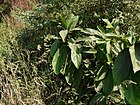Note: This is a project under development. The articles on this wiki are just being initiated and broadly incomplete. You can Help creating new pages.
Difference between revisions of "Ficus hispida - Hairy Fig"
| Line 5: | Line 5: | ||
===Food=== | ===Food=== | ||
| − | Ficus hispida can be used in Food. Tender leaves and young unripe fruits are cooked as vegetable. Ripe fruits are eaten raw. | + | Ficus hispida can be used in Food. Tender leaves and young unripe fruits are cooked as vegetable. Ripe fruits are eaten raw<ref name="Forest foods of Western Ghat"/>. |
==Parts Used== | ==Parts Used== | ||
| Line 32: | Line 32: | ||
===Nutritional components=== | ===Nutritional components=== | ||
| − | Ficus hispida Contains the Following nutritional components like - β-sitosterol, lupeol acetate, hispidine, bergapten, psoral and β-amyrin; Calcium, Copper, Iron, Magnesium, Manganese, Phosphorus, Potassium, Sodium, Zinc<ref name=" | + | Ficus hispida Contains the Following nutritional components like - β-sitosterol, lupeol acetate, hispidine, bergapten, psoral and β-amyrin; Calcium, Copper, Iron, Magnesium, Manganese, Phosphorus, Potassium, Sodium, Zinc<ref name="Forest foods of Western Ghat"/>. |
==Habit== | ==Habit== | ||
| Line 57: | Line 57: | ||
==Cultivation Details== | ==Cultivation Details== | ||
| − | Fig trees have a unique form of fertilization, each species relying on a single, highly specialized species of wasp that is itself totaly dependant upon that fig species in order to breed. Ficus hispida is available through January-July<ref name=" | + | Fig trees have a unique form of fertilization, each species relying on a single, highly specialized species of wasp that is itself totaly dependant upon that fig species in order to breed<ref name="How to plant/cultivate"/>. Ficus hispida is available through January-July<ref name="Forest foods of Western Ghat"/>. |
==Commonly seen growing in areas== | ==Commonly seen growing in areas== | ||
Revision as of 13:00, 27 October 2021
Ficus hispida is a shrub or small tree. It can grow up to 17 metres tall with a bole up to 25cm in diameter. The tree is sometimes harvested from the wild for use as a food and medicine.
Contents
- 1 Uses
- 2 Parts Used
- 3 Chemical Composition
- 4 Common names
- 5 Properties
- 6 Habit
- 7 Identification
- 8 List of Ayurvedic medicine in which the herb is used
- 9 Where to get the saplings
- 10 Mode of Propagation
- 11 Cultivation Details
- 12 Commonly seen growing in areas
- 13 Photo Gallery
- 14 References
- 15 External Links
Uses
Food
Ficus hispida can be used in Food. Tender leaves and young unripe fruits are cooked as vegetable. Ripe fruits are eaten raw[2].
Parts Used
Chemical Composition
Common names
| Language | Common name |
|---|---|
| Kannada | |
| Hindi | |
| Malayalam | |
| Tamil | |
| Telugu | |
| Marathi | |
| Gujarathi | |
| Punjabi | |
| Kashmiri | |
| Sanskrit | |
| English |
Properties
Reference: Dravya - Substance, Rasa - Taste, Guna - Qualities, Veerya - Potency, Vipaka - Post-digesion effect, Karma - Pharmacological activity, Prabhava - Therepeutics.
Dravya
Rasa
Guna
Veerya
Vipaka
Karma
Prabhava
Nutritional components
Ficus hispida Contains the Following nutritional components like - β-sitosterol, lupeol acetate, hispidine, bergapten, psoral and β-amyrin; Calcium, Copper, Iron, Magnesium, Manganese, Phosphorus, Potassium, Sodium, Zinc[2].
Habit
Identification
Leaf
| Kind | Shape | Feature |
|---|---|---|
Flower
| Type | Size | Color and composition | Stamen | More information |
|---|---|---|---|---|
| {{{5}}} |
Fruit
| Type | Size | Mass | Appearance | Seeds | More information |
|---|---|---|---|---|---|
Other features
List of Ayurvedic medicine in which the herb is used
Where to get the saplings
Mode of Propagation
Root suckers, Seeds, Air layering.
Cultivation Details
Fig trees have a unique form of fertilization, each species relying on a single, highly specialized species of wasp that is itself totaly dependant upon that fig species in order to breed[5]. Ficus hispida is available through January-July[2].
Commonly seen growing in areas
Open places, Swamp forests, Along rivers, Along streams.
Photo Gallery
References
Cite error: <ref> tag with name "Nutritional components" defined in <references> is not used in prior text.
External Links
- Pages with reference errors
- Ayurvedic Herbs known to be helpful to treat Fevers
- Ayurvedic Herbs known to be helpful to treat Liver problems
- Herbs with Fruits used in medicine
- Habit - Evergreen tree
- Index of Plants which can be propagated by Root suckers
- Index of Plants which can be propagated by Seeds
- Index of Plants which can be propagated by Air layering
- Herbs that are commonly seen in the region of Open places
- Herbs that are commonly seen in the region of Swamp forests
- Herbs that are commonly seen in the region of Along rivers
- Herbs that are commonly seen in the region of Along streams
- Herbs
- Pages without herbs images




